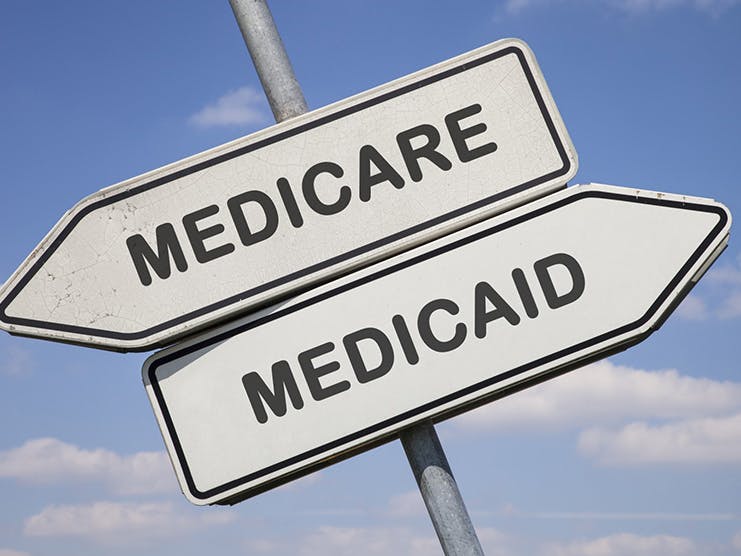
The main difference between Medicare and Medicaid is how you qualify for each program.
With such similar sounding names, it can be easy to confuse Medicare and Medicaid. Add in the fact that they are both government-run programs designed to help beneficiaries pay for healthcare costs and it's no wonder many people confuse the two.
In reality, each program has vastly different requirements and benefits. However, it's possible to qualify for both. In this article, learn more about each program, key differences between them, and how you might qualify for Medicare, Medicaid, or both.
What is Original Medicare?
Original Medicare is made up of two parts:
- Part A, also called hospital care, covers inpatient hospital care when you've been admitted to the hospital as an inpatient.
- Part B, also called medical insurance, helps pay for outpatient services like doctor visits, lab work, mental health care, lab screenings, durable medical equipment (DME), and more. Part B also covers some vaccinations, such as a flu shot, COVID vaccine, and pneumococcal shots. Additionally, it covers some medications administered in a medical setting.
Like most other types of health insurance, you have a variety of out-of-pocket costs with Original Medicare, including:
- Premiums, which are your monthly cost
- Deductibles, which are paid each benefit period and must be met before Medicare begins paying its share
- Co-pays, which are typically a set dollar amount you pay for covered services
- Co-insurance, which is a percentage that you'd pay for covered services
What is Medicare Part C?
Part C, also known as Medicare Advantage (MA), is offered by private insurance companies and includes the same coverage as Medicare Part A and Part B, plus more. Additional coverage can include:
- Prescription drug coverage
- Routine vision services
- Routine dental care
- Hearing aids
- Fitness programs
The availability these plans varies by zip code, and the cost varies by plan. Some plans offer $0 premiums or low deductibles, while others have monthly premiums (though the average Part C premium in 2023 is around $20). Plus, you still owe the Part B premium if you join a Part C plan.
What is Medicare Part D?
Medicare Part D providers prescription drug coverage. You can get coverage by either:
- Joining a standalone Part D plan (keeping Original Medicare Part A and Part B); OR
- Joining a Medicare Advantage Prescription Drug plan (MA-PD)
Part D plans are offered by private insurance companies who work within guidelines set by the Centers for Medicare & Medicaid Services (CMS). Each plan must cover certain types of medications, such as anti-depressants and anti-coagulants, but other drugs covered can be found within the plan's formulary.
Monthly premiums, deductibles, and other costs for Part D plans vary by plan. Drug co-pays and co-insurance also vary based on the "tiers" the plan places each medication on. The higher the tier, the higher your out-of-pocket costs will be for that particular drug.
What is Medicaid?
Medicaid is a state level health insurance program funded by federal and state taxes. The program helps with medical costs for some people with limited income and resources, and offers additional benefits not normally covered by other insurance, including Medicare.
Medicaid works like having other private health insurance: Enrollees are given a card to present at the doctor's office, and if the doctor participates in Medicaid, the state will pay for the appointment (minus the contribution of any other health insurance the individual carries).
How to qualify for Medicare or Medicaid
Because Medicare and Medicaid are different entities, there are different eligibility requirements to qualify for coverage.
Qualifying for Medicare
Part A and Part B are available to individuals who are:
- Age 65 or older; OR
- Disabled; OR
- Have end-stage renal disease (ESRD)
To be eligible for premium-free Part A, you must be entitled to receive Medicare based on your earnings (or those of a spouse, parent, or child). This means you've worked a specified number of quarters of coverage and file an application for Social Security or Railroad Retirement Board (RRB) benefits.
Or, to be eligible for Part A on the basis of age, you must be 65 or older and be eligible for monthly Social Security or RRB benefits. You'd then enroll in Medicare through the Social Security Administration.
If you are eligible for premium-free Part A, you're also able to enroll in Part B once you enroll in Part A. If you must pay a premium for Part A, you must also:
- Be age 65 or older;
- Be a U.S. resident; AND
- Be either a U.S. citizen, OR
- Be an alien who has been lawfully admitted for permanent residence and has been residing in the U.S. for five continuous years prior to the month of filing an application for Medicare
Individuals who have been receiving Social Security or RRB benefits for at least four months prior to being eligible for Medicare, and who reside in the U.S., are automatically enrolled in Part A and Part B.
Qualifying for Medicaid
Each state has its own eligibility requirements for Medicaid. However, many states have expanded their programs to cover even more adults. Even if you're unsure if you're eligible for Medicaid, you should still apply. Most of the time, eligibility depends on:
- Household income
- Family size
- Age
- Disability
- Other factors
You must also be a U.S. citizen, a U.S. national, or have a satisfactory immigration status to be eligible for full benefits.
For your state's specific eligibility requirements, visit Medicaid.gov.
If I have Medicaid, do I need Medicare?
In most cases, even if you have Medicaid, you must enroll in Medicare when you're eligible. This is because Medicare is the primary insurance, meaning it will pay for your health care services first before any other insurance, and will provide benefits and coverage you need. If you do not enroll when you're eligible, you risk facing a late enrollment penalty.
Just because you're eligible for Medicare doesn't mean you lose Medicaid coverage. If you meet requirements for both programs, meaning you're dual eligible, you can enroll in both Medicare and Medicaid. In this case, Medicaid would be the secondary insurance.
If you're eligible for both, they will work together to provide you the coverage and services you need:
- Medicaid would pay your Part B premium
- Medicaid helps provide financial assistance for health care, and depending on your circumstances, you could qualify for an additional financial assistance program
- Medicaid can help coordinate your care, such as through a Medicaid Managed Care (MMC) plan or private health plan. You may also have an option to enroll in a Medicare Advantage plan
- Medicaid provides services Medicare doesn't cover, including nursing home care, dental care, transportation, eyeglasses, physical therapy, and other services
Medicaid never pays first for services covered by Medicare, and it only pays after Medicare, employer group health plans, and/or Medicare supplement (Medigap) insurance has paid. In the event you get a service not covered by Medicare, Medicaid would pay for the service and Medicare would only be the primary payer for any Medicare-covered services you receive.
Related Reading: If I Have Medicaid, Do I Need Medicare?
What is a Medicare Savings Program (MSP)?
If you don't qualify for Medicaid but have limited income or resources, you may qualify for a Medicare Savings Program (MSP). These are federally funded programs that help people pay their Medicare out-of-pocket costs.
Administered by each state, there are multiple types of programs available with different qualification requirements:
- Qualified Medicare Beneficiary (QMB) program helps pay Medicare cost-sharing such as deductibles, co-insurance, and co-pays for both Part A and Part B. Enrollment depends on your income
- Specified Low-Income Medicare Beneficiary (SLMB) program helps pay for Part B premiums
- Qualifying Individual (QI) program helps pay Part B premiums, but you must reapply for benefits each year
- Qualified Disabled and Working Individuals (QDWI) program is designed for individuals under age 65 who have disabilities, and helps to pay for Part A premiums
Related Reading: How to Qualify for a Medicare Savings Program
Part B premium reimbursement
There are other ways to have your Medicare Part B premium paid, even if you don't qualify for Medicaid or an MSP. One way is through the Medicare giveback benefit, or Part B premium reduction plan, which is when a Medicare Advantage plan reduces the amount you pay toward your Part B monthly premium.
The reimbursement could range from less than $1 to the full premium amount, which is $164.90 in 2023. While you don't technically get the money back, you would pay the reduced premium amount, which saves you money.
Related Reading: Who Is Eligible for Medicare Part B Premium Reimbursement?
For more information, or to find a plan in your area that meets your needs, use our Find a Plan tool or call us toll-free to speak to a licensed agent.
Additional resources
Medicare-Medicaid Dual Eligibility
External Website Link



